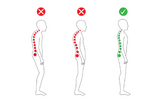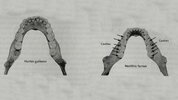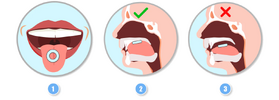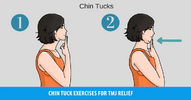D
Deleted member 42181
Guest
Symmetry Looksmaxxing Guide: The key to attractive success
Table Of Contents:
- Introduction
- Facial Symmetry
- The Importance of a Good Nutrition
- Correct Symmetry
- How To Enhance Symmetry
The first thing you should know is that you can improve your facial symmetry; well, the bones that make up our facial structure do not fuse with each other until very old. With which, it retains a small amount of movement during most of our lives, if we take advantage of that movement over time, we can achieve important changes in our health and in our appearance.
Facial Symmetry
What do facial asymmetries cause us? We can alter the development of our face if we smoke, if we have teething problems, if we have a postural alteration and even if we have worse vision in one eye than in the other. The problem appears when we want to understand what part of a symmetry is caused by our genetics and what part is caused by bad habits. To answer this same question and understand that we can change our facial asymmetry, a 2014 study evaluated 147 pairs of twin brothers to see what were the factors that altered facial symmetry and since these pairs of twin brothers are genetically the same, it can be understand with them what factors really influence the development of the face and facial symmetry, because you can compare the twin who smokes vs. who does not smoke, for example, and the study showed that the twins who slept face down had a greater deviation of the nose and from the corner of the mouth to one side, than those who slept on their backs or on their sides. In addition, the twins who had teeth extracted or who smoked had more cant in the ocusal plane, basically one side of the mouth lowered than the other.
(https://pubmed.ncbi.nlm.nih.gov/253...ors such as,risk factors for facial asymmetry.)
Therefore, your best option is to sleep on your back/side (without a pillow and if possible, sleep on the floor), not to smoke cigarettes or any other drugs and, of course, to solve any problem that has to do with your teeth or your dental arch.

Muscles
These bones can move and there are passive forces, like sleeping position, that will move us. But what's it that can actually displace a bone? The same thing that moves all the other bones, the muscles. This is central, because our muscular development and the tension that these muscles (of the face, mouth and neck) generate in the bone are the key to good facial symmetry. For much of their evolutionary history, especially in the Paleolithic, humans found foods much harder to chew than today's ultra-processed foods that were easy to chew and swallow. This caused two things:
- At first, you developed more chewing muscles (they had more use)
- Secondly, over the years, this gave a greater development of the jaw and a wider dental arch (less problems with the wisdom tooth and no malocclusions were generated)
What habits can I acquire?
Chew more, train your chewing muscles to help your jaw, especially if you do it with real food and not processed food. Since in addition to helping you develop your jaw, this will help you extract more nutrients from a food that you are consuming and if in addition to all this you eat a low glycemic index diet, you will take better care of your teeth and the bacterial flora of your mouth, reducing the chance of losing teeth when you age. That is why, in the Paleolithic era, the wear of the teeth due to the effort and the amount of chewing was common. But, it was not so common to lose many teeth due to infections or cavities.

Tongue
Like the muscles of mastication, it plays a central role in jaw development by exerting force from the outside. The tongue, which is an extremely strong muscle, determines the development of your palate and upper jaw bones. From inside your mouth, the correct position of the tongue on the palate helps guide the upper jaw bones forward and laterally.
Why does the movement of the maxillary bones matter? - Why is the position of the tongue so central to having a symmetrical and healthier face?
To answer this, let's see what happens in a face when it is developed without the pressure exerted by the tongue on the jaws; when we have respiratory allergies or difficulties breathing through the nose and we use our mouth to breathe, it is impossible for us to maintain the correct position of the tongue, this prevents our face from developing forward and growing in the only direction it can, downward. This growth towards the bottom of the face instead of towards the front, not only leads to aesthetic problems, it also leads to health problems. So what can we do about it? Correct the bad posture of our tongue, this always helps us, it doesn't matter if I'm 70 years old with an ass more wrinkled than a raisin and I think that my bones are no longer going to move or, if I'm 18 and I can generate a great aesthetic change, because correcting the posture of our tongue helps us breathe better and makes it easier to always breathe through the nose, especially when sleeping and to be able to know if you have a bad tongue posture by testing your swallowing.
Steps:
1. Position the base and the rest of the tongue against the palate so that the tip of the tongue is in contact with the palatal recess.
2. With your head straight, try to swallow without touching your teeth.
Do you feel how difficult this swallow is compared to what most of us unfortunately do?
This is the swallow that we should all have and, there are exercises to correct atypical swallowing, here I have attached some that could help you improve it in in case you notice that you have a very bad swallow (you push with your teeth, your tongue is not on the roof of your mouth, etc.)
Or, you can go to an orthodontist and / or myofunctional to correct this.
Is swallowing and tongue posture so important to move a much harder tooth? Yes, according to this study we only need 1.7g of force on the incisors (front teeth) to move them, but our tongue can apply forces of up to 500g on those teeth, with which, obviously, the tongue can move and modify the development of your face. One of the most effective exercises to correct this lingual posture is the "Mewing" technique of Dr. Mike Mew (Orthotropics) which consists of bringing the tongue to its correct position against the palate and exerting gentle upward/forward pressure, seal the lips and, in more severe cases, helping guide the jaws with specifically designed appliances.
What can most of us do to apply this technique in our daily lives?
Firstly, correct atypical swallowing with what I mentioned above and, secondly, set reminders (alarms, wallpaper or write on your calendar) to remember to have the tongue in the correct position and help guide the jaws over time forward and upward and even achieve better nasal breathing. What you're looking for is simply to keep your tongue in the correct position whenever you are not talking, eating or drinking.

Respiratory Allergies
This is something that we must avoid, since any obstruction in our nasal airways leads us to breathe through the mouth and alter the development of our face. Today mouth breathing is becoming more common, mouth breathing makes respiratory infections more likely, and even decreases the arrival of oxygen to the brain. By keeping the mouth open we prevent the correct position of the tongue, the development of the dental arch and the upper jaws and, if moving the upper jaws forward/up makes a more attractive and symmetrical face, mouth breathing does the opposite (arch smaller teeth and facial development that is not forward but inferior).
Therefore, we want to avoid it, but what do we do when we have had allergies and/or obstructions that prevent us from breathing through the nose for a lifetime? In that case, we correct what we can:
1. We can test if we breathe through the nose when we sleep. 8h per day breathing through the mouth is too many hours, even if during the day we breathe well. In the first place, we can discover if we breathe through the nose with the help of another person who can evaluate if our mouth is open or, simply by using a piece of hypoallergenic tape to the lips to close them when sleeping and if you're short of breath you're going to open your mouth peeling off the tape and you're going to wake up without it. If you notice that you are breathing through your mouth both awake and asleep, you can correct it using the breathing method called Buteyko, I am not going to put too much emphasis on this, here is a link that explains what it is and how to do it:
(

Buteyko Breathing, Exercises, Techniques For Asthma, Benefits
Use effortless quiet breathing, try Buteyko Breathing for asthma and other benefits. Helps to reduce stress & anxiety with this technique.
This respiratory method helps you clear the airways, increase your tolerance to CO2, distribute more oxygen due to an effect called Bohr or reduce symptoms of respiratory allergies. Secondly, the worse bacterial flora we have, the more problems related to allergies and autoimmune diseases we will have. Therefore, it's important to maintain a healthy bacterial flora, the simplest way to improve our bacterial flora is to use prebiotics (soluble fiber) both in food and in the form of supplements. Also, if you can't eat vegetables or don't want to, you can add prebiotics to your drinks. The foods that most cause allergies and/or food intolerances can also affect correct nasal breathing, such as; dairy in lactose intolerant people.
Keep in mind that the more we develop our face forward, the easier it is for us not to have deviation of the nasal septum, which is also one of the factors that makes it difficult to breathe correctly through the nose. In general, sinusitis symptoms (especially chronic ones and respiratory allergies) can modify the development of our face for the worse.
The Importance of a Good Nutrition
These foods that we are going to see are rich in all the fat-soluble vitamins, in Vitamin A, in Vitamin D, in Vitamin E and in Vitamin K. So, we all know that vitamins are essential for our health, but surely you wonder what the hell these vitamins have to do with the development of facial symmetry, after all they are just vitamins, right? Apparently they have a lot to do with it. Studies in mice, for example, showed that if the mother lacks Vitamin K2 during pregnancy, alterations appear in the morphology of the mouse's face during its development and, in humans, during the development of the embryo, proteins dependent on this Vitamin K2 are concentrated in the septum of the nose to help guide the face anteriorly and laterally, if K2 is lacking this leads to premature ossification and to be able to develop the maxillary bones correctly, which, as we already know, are central to facial symmetry and, in turn, Vitamin K2 works in conjunction with Vitamin D3, which are central to bone remodeling. On the other hand, Vitamin A does much more than maintain healthy skin or help your eyesight, but also in the expression of the phenotype of our DNA, that is, all the characteristics that we can see from the genetic information, what you are going to express, what is going to be seen from the outside, less Vitamin A = worse expression of these characteristics during development and less Vitamin E means more difficulty in repairing a tissue when it has to change its shape. In addition, all these vitamins promote the development of a good bacterial flora and, therefore, a good immune system that will contribute to having fewer respiratory allergies and will allow you to breathe through the nose more easily.
What does a diet include to help us recover asymmetries?
- Real unprocessed foods, such as:
- Free-range meat and offal
- Fish that are not from fish farms, shellfish and fish eggs.
- Some fermented drinks and, in some cases, yoghurts.
- Olive oil (as long as it is not hot)
- Coconut, palm or oils rich in saturated fats if you are going to use them to heat.
- Organic vegetables and fruits.
- Legumes that were generally soaked or sprouted.
- Nuts.
- Salts and spices to Incorporate the necessary minerals.

Note: This diet should never include substances that are inflammatory, substances that generate more respiratory allergies or substances that in any way hinder proper digestive or respiratory function.
Correct Symmetry
The main points that affect our symmetry of the whole body, not only our face, are our feet and mouth; in the case of the feet it is easy to understand, they support all our weight and it is logical that the distribution of that weight changes if we lock ourselves in "boxes" (shoes) all day that prevent normal mobility. Not to mention if we wear high-heeled shoes, which represent a dilemma for anyone who wears them, they give someone the possibility of making their silhouette more "attractive" today at a cost of greater development of asymmetries and joint problems in the future. Which is the solution then? How can we improve our alignment and symmetry from the feet? First of all, we must know that our feet evolved to bear weight barefoot, in a position where the big toe can pull and the other toes stabilize the step. To recover the normal footprint little by little and correct the asymmetries caused by our feet in the first place, I recommend spending as much time as possible barefoot. Secondly, check if you are walking with the balls of your feet forward, many people walk with their feet slightly displaced outwards and this usually happens due to some alignment alterations that may arise in the knee or hip. Thirdly, if it is an option, choose a shoe that allows normal foot movement, at least one that does not raise your heel, because despite being terribly unsightly, they are the type of shoe that makes it easier for us to correct movement of our feet.
To evaluate all this, take a full body photo in front of a mirror, evaluating if there are alterations in symmetry, one shoulder higher than the other, one or both knees turned inward or backward, one hip higher than the other, etc... and if you notice that there is an asymmetric part of the body, you can do alignment exercises for that specific sector.

Cervicals and Neck
It is increasingly common to have cervical pathologies or pain in the neck due to poor posture. In part, because we straighten our cervicals and our head weighs more for our torso if it is displaced forward than if it is in its correct position. It's very difficult to have a good respiratory pattern and "harmonious" facial development if our head is displaced anteriorly. So the question is, how do we correct this postural problem? We can, on the one hand, perform cervical alignment exercises and also, you can do neck muscle stretching exercises such as "Chin Tuck". Combining these exercises over time helps correct neck alignment and compensate for sitting at a desk all day or using a phone.

How To Enhance Your Symmetry
Logically, someone who is a teenager and has not finished developing his face will have much more results than a 70-year-old person, but we can all obtain important results, and there are many reasons why we should put into practice the tools that I mentioned above:
- Increases your energy levels. First of all, correcting our breathing improves the functioning of our mitochondria and gives us more energy.
- Breathing methods: Buteyko or Wim Hof. These can improve our mood.
- These changes improve nasal breathing and decrease respiratory allergies.
- This process helps keep the teeth aligned. There is no point in doing orthodontic treatment if I have a small palate and poor lingual posture, because after the treatment I will move my teeth again.
- A symmetrical face makes us healthier and gives us more confidence. We tend to consider more attractive faces that are more symmetrical and with the upper jaws in their correct position.
- Better oxygenation means better brain function.
- Tongue posture correction
- Chewing exercises: hard-chew gum (Falim or Xios Mastiha) and/or harder foods rich in fiber
- Train your swallowing: if you see your tongue pushing your teeth instead of the palate when you swallow.
- Improve your breathing: respiratory techniques such as Buteyko and/or Wim Hof.
- Intraoral Face Pulling: You can use more complex techniques such as "intraoral pulling" or "face pulling" that are more effective, but also more difficult to carry out.
Working your jaw and masticatory muscles can help your face develop laterally, and positioning your tongue and upper dental arch can help your face develop anteriorly, making it more symmetrical and more proportionate. These techniques are safe and can be done by all of you except people with very significant temporomandibular joint problems.





